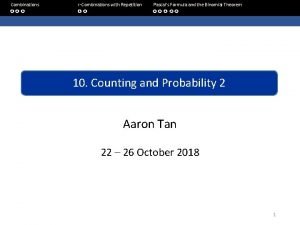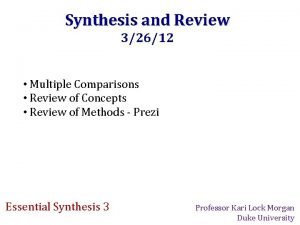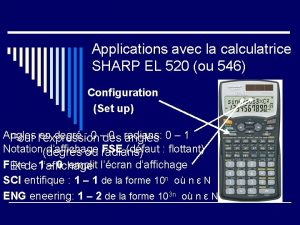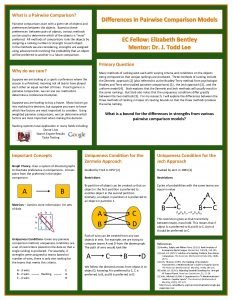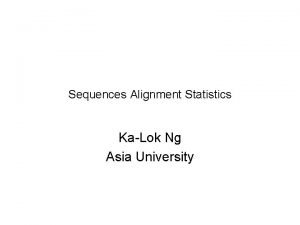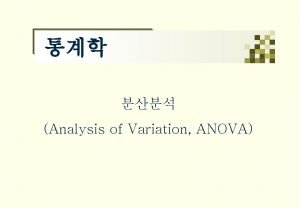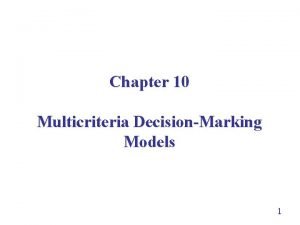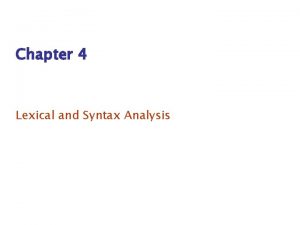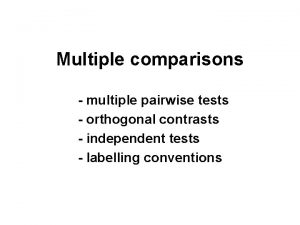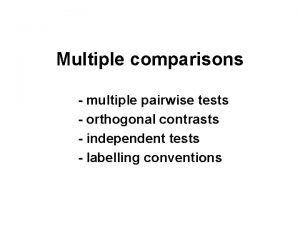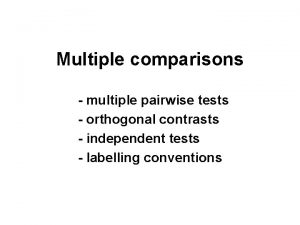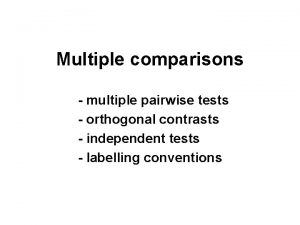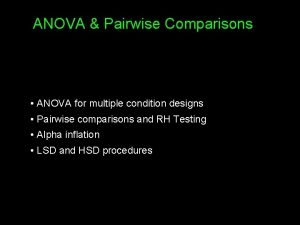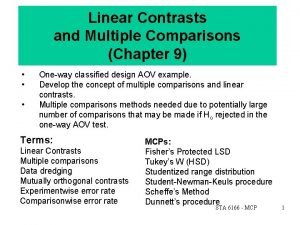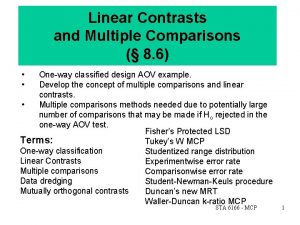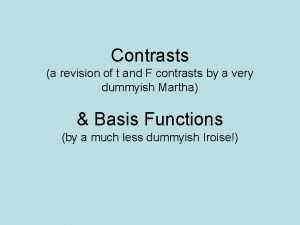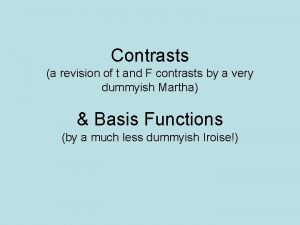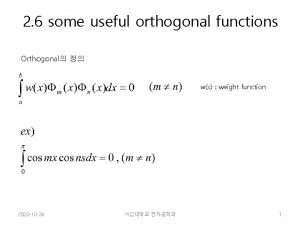Multiple comparisons multiple pairwise tests orthogonal contrasts independent






















- Slides: 22

Multiple comparisons - multiple pairwise tests - orthogonal contrasts - independent tests - labelling conventions

Multiple tests Problem: Because we examine the same data in multiple comparisons, the result of the first comparison affects our expectation of the next comparison.

3 treatments: a, no active management b, selective logging c, replanting Look at the effect of each treatment on Orang-utan births

Multiple tests Births per km 2 ANOVA gives f(2, 27) = 5. 82, p < 0. 05. Therefore at least one different, but which one(s)? significant Not significant • T-tests of all pairwise combinations

Births per km 2 Multiple tests T-test: <5% chance that this difference was a fluke… affects likelihood of finding a difference in this pair!

Births per km 2 Multiple tests T-test: <5% chance that this difference was a fluke… Solution: Make alpha your overall “experiment-wise” error rate affects likelihood (alpha) of finding a difference in this pair!

Multiple tests Births per km 2 Solution: Make alpha your overall “experiment-wise” error rate e. g. simple Bonferroni: Divide alpha by number of tests Alpha / 3 = 0. 0167

Multiple tests Births per km 2 Tukey post-hoc testing does this for you Uses the qdistribution Does all the pairwise comparisons. 1 -2, p < 0. 05 1 -3, p > 0. 05 2 -3, p < 0. 05

Orthogonal contrasts Orthogonal = perpendicular = independent Contrast = comparison Example. We compare the growth of three types of plants: Legumes, graminoids, and asters. These 2 contrasts are orthogonal: 1. Legumes vs. non-legumes (graminoids, asters) 2. Graminoids vs. asters

Trick for determining if contrasts are orthogonal: 1. In the first contrast, label all treatments in one group with “+” and all treatments in the other group with “-” (doesn’t matter which way round). Legumes + Graminoids - Asters -

Trick for determining if contrasts are orthogonal: 1. In the first contrast, label all treatments in one group with “+” and all treatments in the other group with “-” (doesn’t matter which way round). 2. In each group composed of t treatments, put the number 1/t as the coefficient. If treatment not in contrast, give it the value “ 0”. Legumes +1 Graminoids - 1/2 Asters -1/2

Trick for determining if contrasts are orthogonal: 1. In the first contrast, label all treatments in one group with “+” and all treatments in the other group with “-” (doesn’t matter which way round). 2. In each group composed of t treatments, put the number 1/t as the coefficient. If treatment not in contrast, give it the value “ 0”. 3. Repeat for all other contrasts. Legumes +1 0 Graminoids - 1/2 +1 Asters -1/2 -1

Trick for determining if contrasts are orthogonal: 4. Multiply each column, then sum these products. Legumes +1 0 0 Graminoids - 1/2 +1 - 1/2 Asters -1/2 -1 +1/2 Sum of products = 0

Trick for determining if contrasts are orthogonal: 4. Multiply each column, then sum these products. 5. If this sum = 0 then the contrasts were orthogonal! Legumes +1 0 0 Graminoids - 1/2 +1 - 1/2 Asters -1/2 -1 +1/2 Sum of products = 0

What about these contrasts? 1. Monocots (graminoids) vs. dicots (legumes and asters). 2. Legumes vs. non-legumes

Important! You need to assess orthogonality in each pairwise combination of contrasts. So if 4 contrasts: Contrast 1 and 2, 1 and 3, 1 and 4, 2 and 3, 2 and 4, 3 and 4.

How do you program contrasts in JMP (etc. )? Treatment SS } Contrast 1 } Contrast 2

How do you program contrasts in JMP (etc. )? Normal treatments Legumes vs. nonlegumes Legume Graminoid Aster 1 1 2 2 3 3 1 1 2 2 SStreat Df treat MStreat 122 2 60 67 1 MSerror Df error 10 20 “There was a significant treatment effect (F…). About 53% of the variation between treatments was due to differences between legumes and nonlegumes (F 1, 20 = 6. 7). ” F 1, 20 = (67)/1 = 6. 7 10 From full model!

Even different statistical tests may not be independent ! Example. We examined effects of fertilizer on growth of dandelions in a pasture using an ANOVA. We then repeated the test for growth of grass in the same plots. Problem?

Multiple tests Births per km 2 b a, b a significant Not significant Convention: Treatments with a common letter are not significantly different


 Pairwise independent
Pairwise independent Independent event formula
Independent event formula Iq intelligence
Iq intelligence Xkcd jellybeans
Xkcd jellybeans Pairwise disjoint
Pairwise disjoint Pairwise.org
Pairwise.org Ebi pairwise alignment
Ebi pairwise alignment Difference between blast and fasta
Difference between blast and fasta Types of corelation
Types of corelation Listwise vs pairwise
Listwise vs pairwise Disjoint sets probability
Disjoint sets probability Pairwise comparison
Pairwise comparison Pairwise pict
Pairwise pict Pairwise alignment
Pairwise alignment Pairwise disjoint vs disjoint
Pairwise disjoint vs disjoint Pairwise disjointness test
Pairwise disjointness test Pairwise key
Pairwise key Pairwise comparison anova
Pairwise comparison anova Pairwise exchange method
Pairwise exchange method Pairwise alignment
Pairwise alignment Pairwise comparison matrix
Pairwise comparison matrix Everyday is a new beginning
Everyday is a new beginning Lexical and syntax analysis
Lexical and syntax analysis

